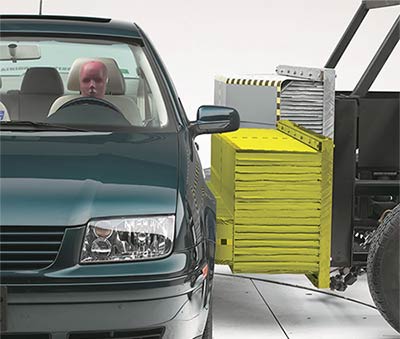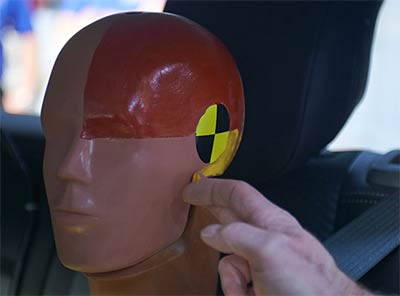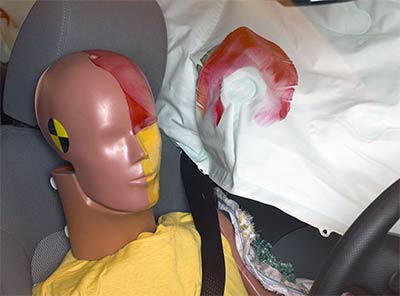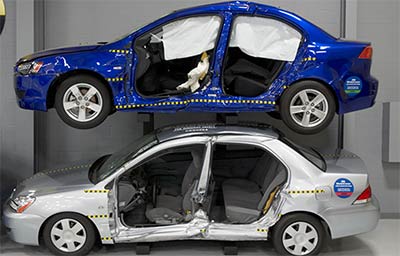Side Impact Testing
By Matthew J. DeGaetano, DC and Adam Shafran, DC

Side crashes account for about a quarter of passenger vehicle occupant deaths in the United States. Protecting people in side crashes is challenging because the sides of vehicles have relatively little space to absorb energy and shield occupants, unlike the fronts and rears, which have substantial crumple zones. Automakers have made big strides in side protection in recent years by installing side airbags and strengthening the structures of vehicles. The Institute’s testing program has played a key role in bringing about these improvements.
Side airbags, which today are standard on most new passenger vehicles, are designed to keep people from colliding with the inside of the vehicle and with objects outside the vehicle in a side crash. They also help by spreading impact forces over a larger area of an occupant’s body. However, side airbags by themselves are not enough. Strong structures that work well with the airbags also are crucial.

NHTSA barrier shown in yellow, superimposed over the taller IIHS barrier
Need for Side Testing
IIHS began its side test program in 2003. At that point, the federal government was already performing side tests on new passenger vehicles as part of the New Car Assessment Program. But the Institute was concerned that the government’s test didn’t completely capture the types of crashes likely to occur in the real world.
That’s because the moving barrier used in the government’s test was developed in the early 1980s, when most of the vehicles on the road were cars, before SUVs and pickups became as prevalent as they are today. The height of the barrier’s front end is below the heads of the crash test dummies. As a result, the federal test doesn’t assess the much greater risk of head injury from impacts with taller vehicles. To fill this gap, IIHS initiated its own test with a different barrier — one with the height and shape of the front end of a typical SUV or pickup.
How the Test Works
In the Institute’s test, a 3,300-pound SUV-like barrier hits the driver side of the vehicle at 31 mph. Two SID-IIs dummies representing small (5th percentile) women or 12-year-old children are positioned in the driver seat and the rear seat behind the driver.
IIHS was the first in the United States to use this smaller dummy in a test for consumer information. It was chosen because women are more likely than men to suffer serious head injuries in real-world side impacts. Shorter drivers have a greater chance of having their heads come into contact with the front end of the striking vehicle in a left-side crash.
The Institute’s side test is severe. It’s unlikely that people in comparable real-world crashes would emerge uninjured. With good side protection, however, people should be able to survive a crash of this severity without serious injuries.
Ratings Criteria
Engineers look at three factors to determine side ratings: driver and passenger injury measures, head protection and structural performance.
Injury measures: Injury measures from the two dummies are used to determine the likelihood that occupants would sustain significant injuries in a real-world crash. Measures are recorded from the head, neck, chest, abdomen, pelvis and femur. These injury measures, especially the ones from the head and upper body, are major components of each vehicle’s overall side rating.

A technician applies greasepaint before a crash test.

Smeared greasepaint shows where the driver dummy’s head hit the side curtain airbag.
Head protection: To supplement head injury measures, technicians put greasepaint on the dummies’ heads before each crash test. After the test, the paint shows what parts of the vehicle or the barrier came into contact with the heads. If the vehicle has airbags and they perform correctly, the paint should end up on them.
In cases when the barrier hits a dummy’s head during impact, the dummy usually records very high injury measures. That might not be true, however, with a “near miss” or a grazing contact. The paint, along with footage of the test recorded on high-speed film, helps identify such cases, which is important because small differences in occupants’ heights or seating positions compared with those of the test dummies could result in a hard contact and high risk of serious head injury.
Structure/safety cage: Engineers assess the vehicle’s structural performance by measuring the amount of intrusion into the occupant compartment around the B-pillar (between the doors). Some intrusion into the occupant compartment is inevitable in serious side impacts, but it shouldn’t seriously compromise the driver and passenger space. As with head protection, this is another assessment that helps evaluate the injury risk of occupants who aren’t exactly the same size or sitting in exactly the same positions as the dummies.
Understanding the Ratings:
How much better are vehicles that earn good ratings?
In the real world, a driver of a vehicle rated good is 70 percent less likely to die in a left-side crash, compared with a driver of a vehicle rated poor. A driver of a vehicle rated acceptable is 64 percent less likely to die, and a driver of a vehicle rated marginal is 49 percent less likely to die.
Those numbers come from an analysis of a decade’s worth of crash data on Institute-rated vehicles. Only vehicles with standard side airbags were included, and the results demonstrate that just having airbags doesn’t guarantee good protection. The Institute’s tests show how airbags and a vehicle’s structure work together in an actual crash. If the occupant space remains largely intact, then the safety belts and side airbags have time to control the motion of the crash test dummies and keep injury measures low. That’s less likely to happen if the side of the vehicle is significantly crushed.
Unlike frontal crash test ratings, side ratings can be compared across vehicle type and weight categories. This is because the kinetic energy involved in the side test depends on the weight and speed of the moving barrier, which are the same in every test. In contrast, the kinetic energy involved in the frontal crash test depends on the speed and weight of the test vehicle.
When side airbags are optional, the Institute tests the vehicle without the option. A second test is conducted with the optional airbags if the manufacturer requests it and reimburses the Institute for the cost of the vehicle. Both results are published on the website.
For information about how ratings are kept up-to-date from one model year to the next, see our test validation information.
Tests Drive Progress
When IIHS began side testing in 2003, only about 1 of 5 vehicles tested earned good ratings. Nearly all of the others were rated poor.

GOOD: 2008 Mitsubishi Lancer with side airbags (top)
POOR: 2005 Mitsubishi Lancer without side airbags (bottom)
Since then, airbags have become standard equipment in the vast majority of passenger vehicles, and occupant compartments have become much stronger. These changes are in large part a direct result of the Institute’s testing program. Manufacturers know consumers consult the ratings before buying, so they design vehicles with our tests in mind. As a result, most current vehicle designs earn good ratings.



